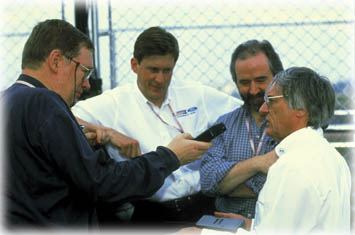 |
|
| The Beginner's Guide to Formula One | |
|
The 1999 Formula One World Championship season will be the 50th season held, since the series began, back in 1950. If you haven't followed Formula One so far, now is a good a time as any to start. For the sake of those who missed the previous episodes, Atlas F1 presents the beginner's guide to Formula One
Other than the football (soccer) World Cup and the Olympic Games, which only take place every four years, more people watch Formula One racing on television than any other sport. What is this motorised, four-wheeled combat all about and what accounts for its phenomenal rise in popularity, particularly over the last 10 years? Almost from the day man came up with the idea of connecting an engine to a previously horse-drawn carriage to create the "horseless" carriage, the more intrepid conductors of these contraptions began exploring their performance and handling limits. The experiments frequently culminated in bent and broken vehicles, but this was more than offset by the excitement of trying to control ever-increasing levels of performance. Predictably, it wasn’t long before one or two drivers with competitive instincts decided it might be good fun to race one car against another, and the concept of motor racing was born. The French and Germans both claim to have been the first to indulge in this exciting new activity, but whatever the truth of the matter, motor racing began to take root in a number of countries in the first two decades of the 20th century.
"Pure" racing cars As motor racing grew, it also divided into a number of clearly identifiable sub-groups. These included sports cars and saloons (sedans), both with bodywork that enclosed the wheels, and single-seat, open-wheel cars. The latter have always been considered the most "pure" type of racing cars since, like fighter aircraft, they are completely functional and totally uncompromising. They also take considerable skill to control and it is only the best drivers who are able to exploit their performance to the full. Formula One, as the name suggests, sits at the top of the single-seater racing "ladder". The regulations governing the sport have changed significantly since the inauguration of the World Championship in 1950, but it remains what it has always been: the most challenging test of man and machine possible within the confines of existing technology. A current-generation Grand Prix car weighs 600 kg with driver in place and is powered by a 3-litre, normally aspirated (non-turbocharged) V10 engine producing just about 800 horsepower (and in some cases even more!) and capable of revving to more than 17,000 rpm (compared with 125-150 hp and maximum revs of 5,000-6,000 in the normal sedan). A combustion engine in the street car runs on a mixture of vapourised fuel and air. In a normally aspirated engine, the mixture is not forced into combustion chambers; rather it enters the chambers at normal atmospheric pressure. It doesn’t take a great deal of imagination to realise this sort of power-to-weight ratio translates into formidable performance – 0-60 mph in less than 2 seconds, 0-100 mph in under 4 seconds, straight-line speeds well in excess of 200 mph and lateral cornering forces of up to 4G (four times the pull of gravity). Flying on the ground
The sport undoubtedly now rivals the aerospace industry in terms of its ability to push forward the boundaries of technology and, in certain areas, Formula One designers, engineers and aerodynamicists are probably working on concepts and with materials more advanced than their aerospace counterparts. So much for the hardware. What about the administration of the sport? Grand Prix motor racing is controlled by the Fédération Internationale de l’Automobile (FIA), the world governing body for motorsport headed by Briton, Max Mosley. This organisation, nowadays settling in Switzerland, administers the sport through a series of national bodies (ASNs) and is responsible for overseeing all technical and sporting issues related to the operation of Formula One. There are currently 11 teams registered to compete in the FIA Formula One World Championship, with that number likely to increase to 12 by the year 2000. The teams themselves are represented by another body, the Formula One Constructors’ Association (FOCA), headed by former Brabham team owner and now undisputed Formula One chief, Bernie Ecclestone. Sport of the times The Formula One schedule normally consists of 16 or 17 Grands Prix per year, with future plans to increas the calendar to 20 races a year. The majority of these events take place at traditional European venues, but four or five are so-called "long-haul" or "flyaway" races to Canada, South America and southeast Asia. With many other countries wanting to host Grands Prix, however, the shape of the Formula One calendar could change significantly in the years to come.
Ecclestone, who holds the dual positions of President of FOCA and FIA Vice President in charge of Promotional Affairs, made the headlines on a number of occasions during 1997-98, notably because of his aim to "float" the sport on the stock exchange and plans to raise capital for further expansion via a Formula One Eurobond issue. It is clear that, in the last decade, Formula One has assumed a place in the collective consciousness of the general public in a way it has never done before. Whereas previously it was normally restricted to a position on the sports pages of the papers, it is now frequently front-page news. This is in part the result of massive global television exposure, but it also has something to do with the sport catching the mood of the times. Formula One is about modern-day warriors doing battle in the most "high-tech" of environments. It’s unpredictable, it’s exciting, it’s dangerous, and like the best computer games - once you’re hooked, you’re hooked.
|
| Atlas F1 | © 1999 Atlas Formula One Journal. |
| Send comments to: comments@atlasf1.com | Terms & Conditions |


